Rebuild sparks wider streets debate
Michael Fowler
Historic Hawke’s Bay
This photo is of what appears to be an Anzac Day parade on Heretaunga St East, around 1937, near the intersection of Hastings St South.
The two-storeyed wooden building across Hastings St shown in the photo is a grocery store and now forms part of the Hastings City New World carpark.
The first set of buildings on the left of the photo which contains Chas Bone Plumbers, a fish and chip shop and grocery are situated in a temporary building erected after the 1931 Hawke’s Bay earthquake.
The original brick buildings were damaged beyond repair. At the immediate left of the crowd is where City Fitness is now.
Hastings Borough Council allowed temporary building permits of wood and corrugated iron only on the site of the earthquake destroyed buildings.
In some cases, these were put up on the day of the earthquake.
Chas Bone’s temporary building permit was issued on March 13, and they used corrugated iron to erect walls and a roof between two brick walls of their old building that had survived the earthquake. It appears the building was put up before the permit date.
Another building permit was issued on August 21, 1931, and this appears to relate to the structure seen in the photo after the brick walls were demolished. In order to build another temporary structure, it was likely that Chas pleaded financial hardship.
The temporary building shown was pushed back 5ft (1.5m) from its original street position.
Hastings Mayor George Roach wanted the temporary buildings in the central business district set back 5ft on both sides on Heretaunga St between Tomoana and Willowpark Rds.
With most of Hastings buildings needing to be replaced, he thought this would be the ideal opportunity to widen Heretaunga St by 10ft in total (3m).
An ex-mayor, George Ebbett, who had interests in retail property, didn’t agree. Apart from saying the debate of street widening was holding up rebuilding in Hastings, his reasons were unclear.
Much debate followed, and retailers, while initially in favour of the street widening, changed their minds.
Mayor George Roach later reflected: “There was an unfortunate feeling that buildings were going to be chopped about, or to have 5ft taken off. Nothing of the sort would happen.
“What would happen to existing buildings was that when the time came for rebuilding them they would have to be built 5ft back.
“Shops put back 5ft beyond the existing buildings enjoyed the advantages of making it possible for shoppers to stand out of the stream of pedestrian traffic and inspect the windows.”
He seemed to be indicating that the service lanes behind the buildings would be reduced by 5ft, not the actual size of the buildings.
Napier’s streets were very narrow compared to most locations in New Zealand, and they had begun widening Emerson St before the 1931 earthquake and continued after it.
The Napier Borough Council had to work around the surviving Public Trust Building and the since demolished E & D building for Dalton St, which is why today it has a kink in it near Tennyson St.
Hastings’ temporary buildings – of which Hawke’s Bay Tribune editor W C Whitlock referred to as being built in the style of “Klondike”, due to their look of the gold rush town in Yukon, northwest Canada, were supposed to be pulled down by March 13, 1933.
Hastings town clerk Percy Purser wrote to Chas Bone in May 1933 stating that his temporary building permit had expired and that he must give him reasons as to why demolition should not take place.
A further two years was granted until August 1935 for the temporary building, after Chas objected, again likely for financial reasons.
When the building remained after this date, a new town clerk, Noel Harding, wrote to Chas stating: “You will appreciate that these temporary buildings should be replaced by permanent structures, both from an aesthetic point of view, and as a safeguard against fire risk.
“It is thought too, that in many cases persons occupying temporary buildings may have an unfair advantage over competitors in the matter of overhead costs.”
Chas again objected on financial grounds to the request – and nothing more appears to have ever been done about the demolition of the temporary building.
And there the buildings, set back 5ft from the road next to the old Hastings Motors building, stood for another 55 years.
The internal walls, according to a Bone family member, were so thin that conversations could clearly be heard through them.
A fish and chip shop remained next to Chas Bone’s plumbing business throughout the life of the building.
As per the fears of the Hastings Borough Council of fire risk, the fish and chip had a couple of fires over the years – but not serious enough to burn down the whole building.
The Dress for Less Group purchased the group of buildings in 1988 to develop the land, and the occupiers moved out.
In 1990 fire destroyed the building in a suspicious blaze.
Chas Bone Plumbers would be carried on by Chas’ son, Lindsay and by his sons, Peter and Ron.
Ron Bone sold the business in 2000.
This year, according to my calculations, makes it the 100th year of Chas Bone’s existence.
Signed copies of Michael Fowler’s Historic Hawke’s Bay book are available at $65 from the Hastings Community Art Centre, Russell St South, Hastings and Wardini Books Havelock North and Napier.
Michael Fowler FCA ([email protected]) is a chartered accountant, contract researcher and writer of Hawke’s Bay’s history.
Photo caption – Chas Bone Plumbers’ temporary earthquake building in Heretaunga Street East, circa 1937. PHOTO/HAWKE’S BAY KNOWLEDGE BANK, WILSON COLLECTION T2267 Box 1 018












Do you know something about this record?
Please note we cannot verify the accuracy of any information posted by the community.